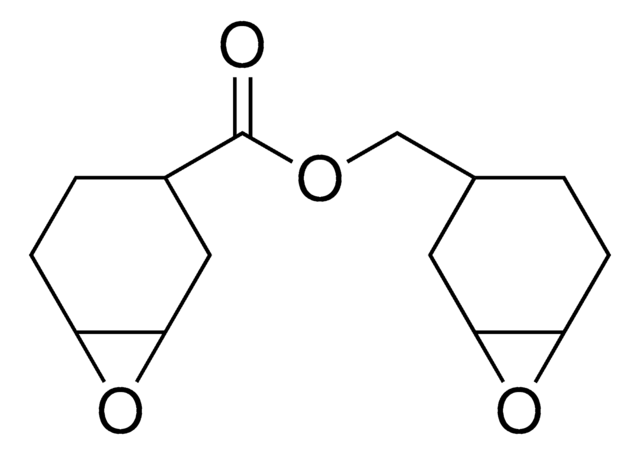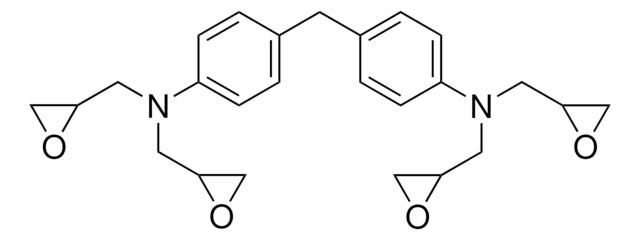Kluczowe dokumenty
430234
Bisphenol A diglycidyl ether, brominated
mol wt 350-450 g/epoxide by perchloric acid method
Synonim(y):
4,4′-(1-Methylethylidene)bis[2,6-dibromophenol] polymer with (chloromethyl)oxirane, 4,4′-(1-methylethylidene)bis(2,6-dibromophenol), Tetrabromobisphenol A-epichlorohydrin polymer
About This Item
Polecane produkty
Formularz
solid
Poziom jakości
masa cząsteczkowa
350-450 g/epoxide by perchloric acid method
zakres etykietowania
48 wt. % Br
lepkość
1,800 cSt(lit.)
mp
55-65 °C (lit.)
temp. przejścia
softening point 55-65 °C (Durrans)
rozpuszczalność
a variety of ketone, aromatic hydrocarbon and ether alcohol solvents: soluble
ciąg SMILES
Brc2c(c(cc(c2)C(C)(C)c3cc(c(c(c3)Br)O)Br)Br)O.ClCC1OC1
InChI
1S/C15H12Br4O2.C3H5ClO/c1-15(2,7-3-9(16)13(20)10(17)4-7)8-5-11(18)14(21)12(19)6-8;4-1-3-2-5-3/h3-6,20-21H,1-2H3;3H,1-2H2
Klucz InChI
DEGGCMXJUHYWMD-UHFFFAOYSA-N
Opis ogólny
Zastosowanie
Właściwości fizyczne
Hasło ostrzegawcze
Warning
Zwroty wskazujące rodzaj zagrożenia
Zwroty wskazujące środki ostrożności
Klasyfikacja zagrożeń
Eye Irrit. 2 - Skin Sens. 1
Kod klasy składowania
11 - Combustible Solids
Klasa zagrożenia wodnego (WGK)
WGK 3
Temperatura zapłonu (°F)
235.4 °F - closed cup
Temperatura zapłonu (°C)
113 °C - closed cup
Środki ochrony indywidualnej
dust mask type N95 (US), Eyeshields, Faceshields, Gloves
Wybierz jedną z najnowszych wersji:
Masz już ten produkt?
Dokumenty związane z niedawno zakupionymi produktami zostały zamieszczone w Bibliotece dokumentów.
Klienci oglądali również te produkty
Nasz zespół naukowców ma doświadczenie we wszystkich obszarach badań, w tym w naukach przyrodniczych, materiałoznawstwie, syntezie chemicznej, chromatografii, analityce i wielu innych dziedzinach.
Skontaktuj się z zespołem ds. pomocy technicznej




![Bis[4-(glycidyloxy)phenyl]methane mixture of isomers](/deepweb/assets/sigmaaldrich/product/structures/915/436/edb8eab6-834e-4238-a904-bf72c573b686/640/edb8eab6-834e-4238-a904-bf72c573b686.png)


